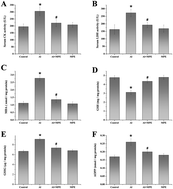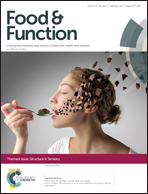Mung bean (Phaseolus radiatus L.) polyphenol extract attenuates aluminum-induced cardiotoxicity through an ROS-triggered Ca2+/JNK/NF-κB signaling pathway in rats†
Abstract
Aluminum (Al) has been linked to the development of some cardiovascular diseases and mung bean is a functional food with the ability to detoxify. We aimed to evaluate the preventive effect and possible underlying mechanisms of the mung bean polyphenol extract (MPE) on Al-induced cardiotoxicity. Control, AlCl3 (171.8 mg Al per kg body weight), MPE + AlCl3 (Al-treatment plus 200 mg MPE per kg body weight), and a group of MPE per se were used. Al intake induced a significant increase of serum CK and LDH activity and the level of Na+, Ca2+, malondialdehyde and advanced oxidation protein products in the AlCl3-treated rats’ heart tissue. Administration of MPE significantly improved the integrity and normal ion levels of heart tissue, and attenuated oxidative damage and the accumulation of Al in Al-treated rats. MPE significantly inhibited Al-induced increase of myocardial p-JNK, cytoplasmic NF-κB, cytochrome C, and caspase-9 protein expressions. Therefore, these results showed that MPE has a cardiac protective effect against Al-induced biotoxicity through ROS-JNK and NF-κB-mediated caspase pathways. Furthermore, the stability constant for the vitexin-Al complex was analyzed (log K = log K1 + log K2 = 4.91 + 4.85 = 9.76). We found that MPE-mediated protection against Al-cardiotoxicity is connected both with MPE antioxidant and chelation properties.



 Please wait while we load your content...
Please wait while we load your content...